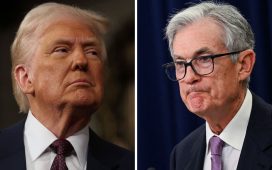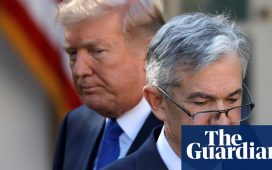Unlock the Editor’s Digest for free
Roula Khalaf, Editor of the FT, selects her favourite stories in this weekly newsletter.
This article is an on-site version of our Unhedged newsletter. Sign up here to get the newsletter sent straight to your inbox every weekday
Good morning. Ethan here; Rob is off. A few readers kindly wrote in to cure our confusion about last week’s bumper jobs report. Unfortunately, half told us the labour market is weaker than it seems, while the other half said strength would probably continue. For its part, the bond market seems to believe the jobs numbers. The 10-year yield is up 30 basis points in the past two trading days. Email me: ethan.wu@ft.com.
The crowded corporate credit trade, part 2
Last week I looked at the boom in corporate credit and the accompanying tight credit spreads in high-yield and investment-grade bonds. I made the point by looking at spreads over Treasuries since the financial crisis, and noting that they’re in the bottom decile of tightness.
But it’s even more extreme than that. The chart below, courtesy of Marty Fridson of Lehmann Livian Fridson Advisors, makes the point. Fridson models the relationship between HY spreads and other indicators, including Bloomberg consensus recession probability and the five-year Treasury yield, with data since the end of 1996. For example, the historical range of HY spreads that have coincided with today’s recession odds (40-50 per cent) is between 483bp and 1726bp. The median spread during 40-50 per cent recession odds is 795bp, compared with the current reading of 347bp. That pattern of uber-tightness holds across correlates. As the chart shows, by some measures today’s HY spreads are narrower than previous records:

Spreads are not expected to widen much, either, because demand appears insatiable. John Higgins of Capital Economics, a forecaster, projects that spreads on IG and HY will end 2024 little changed (though he notes that unexpected economic weakness could change the outlook). New bonds issued by regional banks have been quickly snapped up. Investors easily digested an “exceptionally strong” $30bn in new HY supply in January, the strongest month in two years, says Hussein Adatia, fixed-income portfolio manager at Westwood. He adds:
We expect this trend to continue in February given corporate bond spreads remain tight and issuers are eager to address 2024 and 2025 debt maturities while markets remain accommodative. The dearth of new HY supply over the past two years has left investors flush with cash and they have been more than happy to absorb the new supply (thus far).
How have spreads stayed so tight? One explanation is the best-of-all-worlds combination of falling cyclical risk, expected rate cuts and high current bond yields. With junk-rated yields north of 7 per cent alongside 3 per cent gross domestic product growth, investors needn’t worry about getting paid for taking on default risk, so they look past tight spreads. Coming after a decade of paltry fixed-income returns, it’s no surprise investors are “making up for lost time in bonds”, says Fridson.
This pattern has shown up before. Generally, bond yields and spreads travel together, reflecting the risk of defaults (which push both yields and spreads higher). But when the economy is strong, the two can diverge. The usual close link between HY spreads and yields weakens when US real GDP is growing faster than 3 per cent; the correlation coefficient drops from 0.8 to 0.5. The charts below show four episodes of HY spreads and yields coming apart, including over the past several months. You’ll notice that in some instances yields are rising, while in others they’re falling. What the four have in common are tumbling spreads during benign economic conditions (please forgive the ugly Excel graphs!):

It’s clear, then, why investors have been so into corporate credit. But is a trade so crowded still any good? An intuition you might bring from equities land is that high starting valuations imply lower expected returns. Bonds are not equities, of course. But if you overpay for credit risk, realised returns might turn out a lot worse than the yield you were initially promised.
I recently put that question to David Rosenberg, who runs Oaktree’s HY and IG bond business as well as its global credit strategy. Notwithstanding tight spreads, he still likes the trade. Spreads, he notes, are only one of three components that matter to corporate credit. The other two, price and yield, look quite attractive. Yields are in an equity-like range. And the average price on bonds in the Ice-BofA HY index is 92 cents on the dollar. Because bonds mature at face value, investors will receive extra returns through the “pull to par” effect as the bonds age.
At current valuations, though, Rosenberg prefers HY to IG for two reasons. The first is that while HY spreads may be tight relative to history, HY still gives you a meaningful step up in absolute returns versus Treasuries. On the other hand, IG’s yield is so close to that of Treasuries that investors are more reliant on rates falling to deliver outperformance. Here’s Rosenberg:
The concept that we’re going to have a soft landing or no landing with five rate cuts doesn’t seem likely to me . . .
When I look at the difference between IG and high yield today, the reality is you’re picking up 200-250 basis points of yield. You’re picking up risk, but you’re getting paid for it. In IG today, you need rates to go down for that trade to work. Eventually they’ll come down, but I’m not sure it’ll be as quick as the market expects. In high yield, I don’t need rates to come down because the coupon is so much higher.
The past decade of IG-vs-HY performance bears this out. Returns for IG, which has longer duration than HY, track those for long-dated Treasuries. IG, in other words, is largely a rates bet. However, HY significantly outperformed the relevant Treasury benchmark, helped by a mostly gentle credit cycle (charts from regular Unhedged correspondent Dec Mullarkey of SLC Management):

Rosenberg’s second point in favour of HY is quality. As we’ve discussed before, the HY bond universe has seen a big improvement in the composition of credit ratings. About half the market is made up of double-B bonds, the highest-quality rung, up from about a third a decade ago. The coronavirus pandemic only accentuated this, by killing off some of the weakest credits. The share of triple-C bonds, the junkiest sort, is at a decade low. Rosenberg again:
There’s no bargain if you’re just going to take a bunch of risk to get more yield. Anyone can do that. The art of this business is to get the yield and keep risk low . . .
Today, the mix of quality is the best we’ve seen in a decade. While many people say spreads are just OK, I say, sure, but quality is really good. So if I can get a yield that’s high and a quality that’s high, that is very rare. The difference today is that the yield is high, not because people are scared and spreads are wide, but because the base rate is high. That allows you to get income without having to take undue risk.
All this gets to an important difference between a bull market in equities and one in bonds. Equity investors need earnings growth to do well. However, bonds are contracts; investors just need enough cash flow to get paid. Aside from the riskiest slices, corporate bonds usually require a significant economic dislocation (a recession, an oil price collapse) to flop. It is obviously still possible to post poor returns in bonds. But animal spirits are safer in some markets than in others.
One good read
FT Unhedged podcast

Can’t get enough of Unhedged? Listen to our new podcast, hosted by Ethan Wu and Katie Martin, for a 15-minute dive into the latest markets news and financial headlines, twice a week. Catch up on past editions of the newsletter here.









